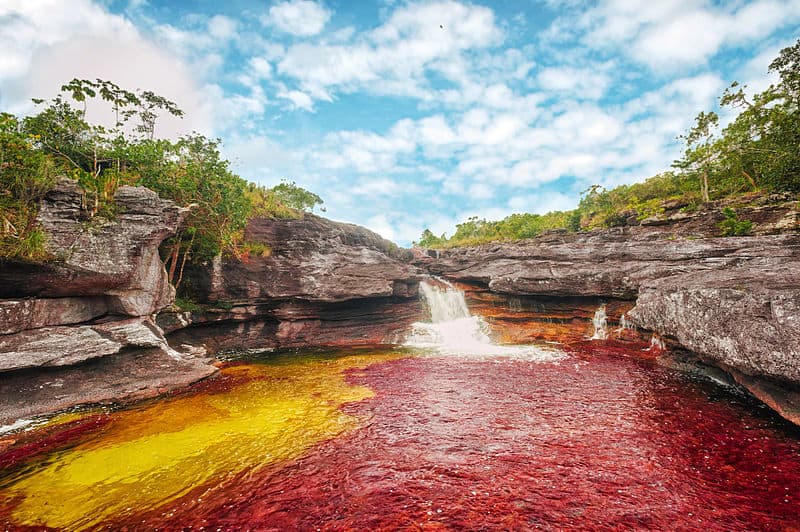Cano Cristales Facts
- This truly astounding marvel of Nature forms a watery kaleidoscope bearing the name of Cano Cristales, Crystal Channel in English. Its mesmerizing beauty easily entrances all those individuals fortunate enough to encounter this marvel of natural processes in person.
- This remarkable geological feature also goes by several other names, especially among the local residents. These alternate names include such vividly descriptive terms as the Liquid Rainbow and the River of Five Colors, just to list a few of the many distinctive titles used.
- This astonishing semblance occurs completely naturally, due to a highly unique and utterly breathtaking combination of geological and botanical factors. As a result of its appearance, many individuals consider this stunning flow to be the most beautiful river on earth.
- This opinion largely exists due to the fact that the river presents a mind-boggling appearance. That’s because it presents a total of five separate colors. For about half of the year, however, only four of the gorgeous colors appear visible. That alone, though, makes it highly remarkable.
- During the other half of the year, though, the fifth color quickly manifests as well, serving to aid in dazzling the viewer. This, therefore, completes the startling transformation of the river. The brilliant colors presented in its waters include those of green, yellow, blue, black, and red.
- The gorgeous Cano Cristales now enjoys a certain amount of protection from the depredations of man. It lies within the Serranía de la Macarena National Natural Park. This biodiversity hotspot’s protected due to its unique ecosystems, endemic species, and geological formations.
Related Articles
Cano Cristales Physical Description
The breathtaking Cano Cristales never fails to immediately capture the attention and imagination of anyone fortunate enough to visit the feature. Unlike some similar flows around the world, however, this marvel of natural formation possesses multiple impressive physical characteristics.
Although it wends its way casually through the surrounding terrain, it stretches for a length that, while it may not compare to rivers like the Amazon River, it’s nonetheless respectable. Overall, this captivating body of water drifts its way for a distance totaling approximately 62 mi (100 km).
Although this water-based wonder certainly boasts hypnotic qualities of other sorts, width does not rank among them. That’s because this remarkable river never attains a span greater than 65 ft (20 m) at any point along its course. In fact, for most of its length it measures notably less than this.
Just as notably, it also maintains a comparatively shallow depth at all times. Even at its most extreme, the water never measures more than 65 ft (20 m) from the floor to the surface. For most of its extent, in fact, the magnificent flow remains significantly less deep than even this minor state.
Without doubt, however, it’s the mind-numbing beauty of Cano Cristales that garners the most attention from visitors and readers alike. These brilliant hues primarily occur due to the presence of a specific aquatic plant. This plant thrives during the wet season, typically from June to November.
Generally, the red shades remain the most predominant of the multiple colors contained within its confines. The relative strength and sharpness of the other tints vary widely, largely depending upon numerous environmental factors, such as water levels and the amount of sunlight received.
Cano Cristales Location, Formation, and Ecology
The almost incomprehensible marvel that’s Cano Cristales formed in a general region of the world already well known for its abundance of natural marvels. The exact location of that unique setting therefore probably won’t surprise many of our readers. Nature created it as part of South America.
Within that greater, and also quite extensive, landmass, though, its location places it within a comparatively remote section of the continent. That area consists of the section that now constitutes the country of Colombia. This unique river additionally lies within in the Meat province.
The river formed through a majestic combination of ancient geological processes and unique ecological conditions that came together over a span of hundreds of millions of years. Its origins remain tied to one of the oldest geological formations on Earth and an exceptional environment.
It flows over quartzite rock that forms part of the Guiana Shield, one of the oldest rock formations on the planet, being approximately 1.2 billion years old. Over great time, natural forces like water erosion and weathering inexorably carved out the river’s channels, waterfalls, and circular pools.
Nature still wasn’t finished, though. Eventually, what now comprises the Serranía de la Macarena mountain range uplifted through tectonic activity. This small, isolated chain separated the region from the Andes, and contributed to its unique mix of Andean, Amazonian, and Orinoco features.
This river one of the most unique and biodiverse ecosystems in its area, shaped by its geological age, location at the convergence of three major ecosystems, and strict environmental protections. Its ecology remains defined by a delicate balance of climate, hydrology, plant life, and endemic species.
The Macarenia clavigera, the mmost iconic plant of Cano Cristales, is responsible for the river’s red, pink, and green hues during the wet season. It grows on submerged rocks in clean, shallow, fast-flowing water. Algae and mosses also coexist with it, although none exhibit the same striking colors.
Due to the low nutrient content, high water clarity, and rocky substrate, it supports only a limited number of fish species. Those present are small and adapted to nutrient-poor, fast-moving water. Crustaceans, aquatic insects, and snails remain more common, forming the base of the food web.
Its waters also support a vast and diverse array of terrestrial wildlife in its area. Some of the mammals include jaguars, pumas, tapirs, and monkeys. Countless insects, poison dart frogs, iguanas, and various snakes also depend on it. Over 400 avian species rely on its waters as well.
Features Sharing Its Region
Check out our other articles on 5 Spellbinding Scorpions, Linville Falls, Longfin Batfish, Tiger Flower, Gharial, Cape Honey Bee, Northern Bald Ibis, Limnonectes larvaepartus

